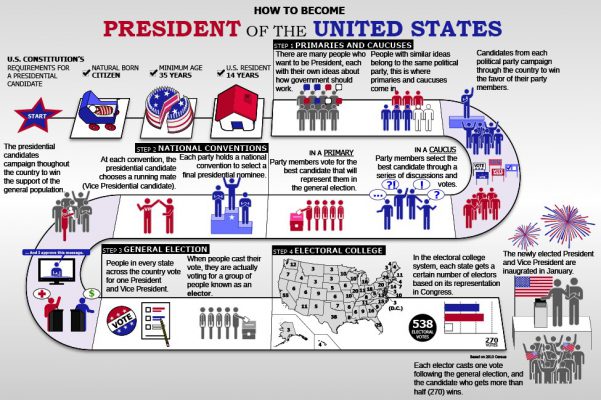- Home
- Prelims
- Mains
- Current Affairs
- Study Materials
- Test Series
US Elections - Basics and Current Issues
The United States has a bicameral legislature consisting of the Senate and the House of Representatives. Direct elections are held to fill the vacancies in these legislatures. In addition, the vacancies in the Senate may be filled by a gubernatorial appointment. Like in India, the minimum age to exercise franchise in the presidential elections is 18-years.
US Presidential election happens once in every four years on Election Day. Election Day falls on the first Tuesday after the first Monday in November.
 Eligibility conditions for a US Presidential candidate
The Presidential candidate must be:
Eligibility conditions for a US Presidential candidate
The Presidential candidate must be:
 Eligibility conditions for a US Presidential candidate
The Presidential candidate must be:
Eligibility conditions for a US Presidential candidate
The Presidential candidate must be:
- A natural-born citizenof the United States (Natural Born Citizens are those who are born in the US or born abroad to the parents both of whom are US citizens or born abroad with one US citizen parent)
- at least 35 years old,
- Should have been a resident of the United States for 14 years.
- In the 2018 midterm elections, it took a week for all the results to be in — a week during which the Democratic swing turned into a Democratic landslide. Such a change is even more possible this year, given the specifics of voting during the pandemic.
- Thus, it is too soon to determine the eventual national margin in the presidential race; even California, the US’ largest state, is about two-thirds through its counting. It does appear that opinion polls in some of the battleground states, such as Wisconsin, were clearly off the mark.
- Whoever wins, the distribution of the popular vote so far is not on the lines the polls had predicted (an 8 percentage point gap). The pollsters have some introspection, and some explaining, to do.
- The chances are that, as they have in six of the last seven presidential elections, the Democratic party will have won more votes than the Republicans, in this case by a decent-sized margin. Even so, who will sit in the White House from January 2021 is still undecided. The fact is that the United States’ electoral and power-transference system is broken.
- Few other democracies have demonstrated this consistent breakdown between voters’ preferences and the assignation of power. In the current election, even the notion of a straightforward transfer of power is being doubted.
- The essential problem remains that elections in the US are excessively decentralised in terms of their rules. In the pivotal state of Pennsylvania for example, some counties are counting their mailed-in ballots alongside their regular votes; and others have said they will not even start counting those till the day after election day.
- In 2000, the election of the most powerful official in the world depended upon Miami counters holding up individual ballots to their eyes and trying to determine if they were punched all the way through or not; this year it might depend upon Philadelphia counters trying to determine whether the date stamps on a few hundred ballot envelopes are legible or not. This is no way to hold an election.
- America’s claim to leadership of the democratic world can hardly hold up, given its elections are unreliable indicators of the political will, are in danger of being ignored by unelected judges and incumbents, and are so slow, complex, and inefficient.









 Latest News
Latest News
 General Studies
General Studies